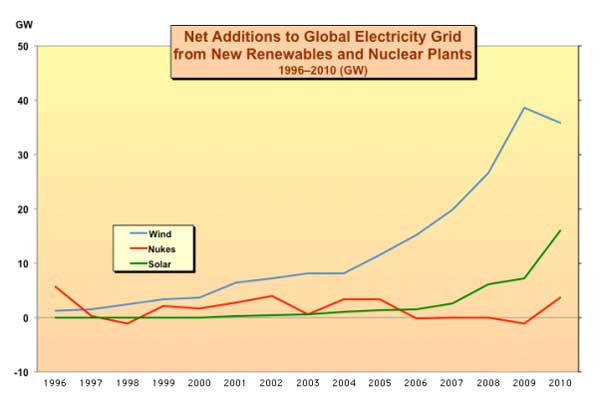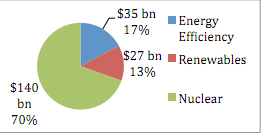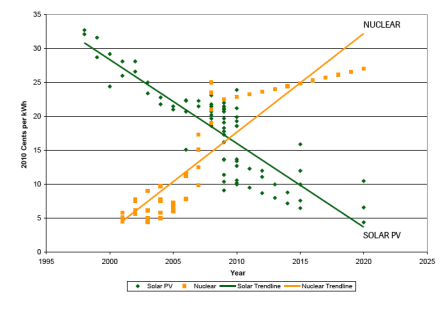Zachary Shahan
It seems that total cumulative installed power capacity from renewable sources passed up nuclear for the first time in 2010, according to the draft version of a new report coming out soon by the Worldwatch Institute, The World Nuclear Industry Status Report 2010-2011.
 |
| Net Additions to Global Electricity Grid from New Renewables and Nuclear Plants 1996-2010 (GW) |
“In 2010, for the first time, worldwide cumulated installed capacity of wind turbines, biomass and waste-to-energy plants, and solar power reached 381 gigawatts, outpacing the installed nuclear capacity of 375 gigawatts,” the draft report says.
Nuclear Renaissance is Hype — Nuclear Declining
While there has been much hype of a nuclear renaissance and I have seen a number of nuclear proponents even try to turn the scenario in Japan into an argument for nuclear, the bottom line is that nuclear has been sliding for awhile. According to the report:
developments even prior to March 11, when the Fukushima crisis began, illustrate that the international nuclear industry has been unable to stop the slow decline of nuclear energy. Not enough new units are coming online, and the world’s reactor fleet is aging quickly. Moreover, it is now evident that nuclear power development cannot keep up with the pace of its renewable energy competitors.
From everything I’ve read, that last sentence nails it, despite the fact that the nuclear industry has received several times more subsidies historically than renewable resources. Renewable energy just makes more sense (I was inclined to write “cents” instead, but thought that might be a little too cheesy).
Nuclear power has been declining for a number of obvious reasons. It is too risky, costs too much, and as such, can’t garner necessary private capital. Even with tremendously unbalanced government support (compared to renewable energy), it is declining while renewable energy is rising.
Nuclear vs Renewable Energy
With nuclear declining and renewable popping onto the scene and growing fast, renewables had been approaching this historic crossover for years:
Annual renewables capacity additions have been outpacing nuclear start-ups for 15 years. In the United States, the share of renewables in new capacity additions skyrocketed from 2 percent in 2004 to 55 percent in 2009, with no new nuclear coming on line. In 2010, for the first time, worldwide cumulated installed capacity of wind turbines (193 gigawatts*), biomass and waste-to-energy plants (65 GW), and solar power (43 GW) reached 381 GW, outpacing the installed nuclear capacity of 375 GW prior to the Fukushima disaster. Total investment in renewable energy technologies has been estimated at $243 billion in 2010.
The natural disasters and nuclear catastrophe in Japan occurred very coincidentally right around the time of this crossover, and it is likely to speed renewable past nuclear much faster:
There could hardly be a more symbolic picture for the tête-a-tête of renewables and nuclear power than the March 2011 earthquake and tsunami in Japan. The disaster shut down 11 of the country’s nuclear reactors, at least six of which are now condemned, but the Japanese Wind Power Association stated, “there has been no wind facility damage reported by any association member, from either the earthquake or the tsunami.”
Within three weeks of the disaster, Fukushima operator TEPCO, one of the five largest electricity utilities in the world, lost more than three-quarters of its share value, while the Japan Wind Development Company nearly doubled its stock price.
Is nuclear going to bounce back? I don’ think so. It may inch back for a short time, but I don’t think it will ever bounce back and regain its relative position in the world energy market, even with coal on the decline as well.
Going back to the unbalanced government support for nuclear versus renewables, the report includes this fact:
“In the United States, even though nuclear and wind technologies produced a comparable amount of energy during their first 15 years (2.6 billion kWh for nuclear versus 1.9 billion kWh for wind), the subsidy to nuclear outweighed that to wind by a factor of over 40 ($39.4 billion versus $900 million).”
Wow, imagine if we subsidized wind (or solar) as much as we subsidized nuclear.
Unfortunately, governments around the world seem addicted to nuclear. Despite the numerous downsides, they seem to have an ongoing hope that some miracle breakthrough will occur (or they are just bought):
Even with the demise of new orders for nuclear power and the rise of other energy technologies, nuclear continues to enjoy unparalleled access to government research and development (R&D) funding. Analysis from the IEA shows the dominance of nuclear power, both fission and fusion, within R&D budgets—commanding nearly two-thirds of total expenditures in recent decades.10 (See Figure 11.) Compared with renewables, nuclear power has received roughly five times as much government R&D finance since 1986 across the countries of the IEA.
 |
| Government Research and Development Budgets across IEA countries 1986–2008 (billion $2008). |
Moreover, the building of new nuclear power plants, which is being proposed for the first time in decades in some developed countries, will require further government subsidies or support schemes, such as production tax credits, insurance for cost overruns, and more. With increasing constraints on public-sector spending, state support for one technology will mean less support available for others.
Will governments change course on this subsidy imbalance? I certainly hope so.
Nuclear-Solar Cost Crossover
As I reported last year, some analysts have found that nuclear and solar have also gone through a historic crossover on real-term prices.
 |
| Solar and Nuclear Costs: The Historic Crossover |
And beyond cost (but surely related to it), it should be noted that nuclear power plants take tremendously longer to get planned, approved, and built than renewable energy projects, and they are less viable in many places. “According to the Global Wind Energy Council, some 50 countries are home to more than 10 MW of installed wind power capacity, compared to 30 countries operating commercial nuclear reactors.”
But nuclear is needed in order to provide baseload power for renewables, right? In response to that, this is a great quote from Siegmar Gabriel, then-Federal Environment Minister of German:
“If someone declares publicly that nuclear power would be needed in the baseload because of fluctuating energy from wind or sun in the grid, he has either not understood how an electricity grid or a nuclear power plant operates, or he consciously lies to the public. Nuclear energy and renewable energies cannot be combined.”
Now, this general renewable energy topic — baseload — is one I will have to get into in another post, because this post seems to have gotten long enough as is. But you can read a thorough explanation of why nuclear and renewables don’t actually jive in Worldwatch’s report.
What the Worldwatch Institute Report Includes
The report goes on to discuss in detail how and why the nuclear industry has been declining and how it is clear that there is no nuclear renaissance on the horizon. In particular, it is divided into the following sections (beyond the executive summary and introduction):
- General Nuclear Power Overview Worldwide
- Potential Newcomer Countries
- Nuclear Economics
- Nuclear Power vs. Renewable Energy Development
- Post-3/11 Developments in Selected Countries (as of 8 April 2011)
